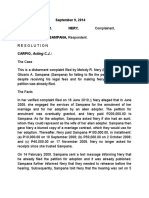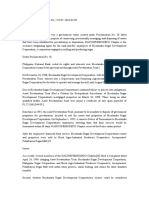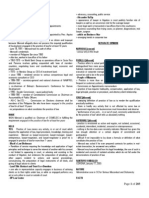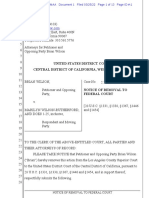Facts:: Alonzo Bagtas Y Alejandrino V. Director of Prisons, GR No. L-3215, 1949-10-06
Facts:: Alonzo Bagtas Y Alejandrino V. Director of Prisons, GR No. L-3215, 1949-10-06
Uploaded by
Jennifer ArcadioCopyright:
Available Formats
Facts:: Alonzo Bagtas Y Alejandrino V. Director of Prisons, GR No. L-3215, 1949-10-06
Facts:: Alonzo Bagtas Y Alejandrino V. Director of Prisons, GR No. L-3215, 1949-10-06
Uploaded by
Jennifer ArcadioOriginal Description:
Original Title
Copyright
Available Formats
Share this document
Did you find this document useful?
Is this content inappropriate?
Copyright:
Available Formats
Facts:: Alonzo Bagtas Y Alejandrino V. Director of Prisons, GR No. L-3215, 1949-10-06
Facts:: Alonzo Bagtas Y Alejandrino V. Director of Prisons, GR No. L-3215, 1949-10-06
Uploaded by
Jennifer ArcadioCopyright:
Available Formats
ALONZO BAGTAS Y ALEJANDRINO v. DIRECTOR OF PRISONS, GR No.
L-3215, 1949-
10-06
Facts:
On various dates between February 18 and May 14, 1948, the petitioner was convicted of
estafa in seventeen criminal cases and sentenced by final judgments of the Court of First
Instance of Manila to an aggregate penalty of 6 years, 4 months, and 26 days of
imprisonment, to indemnify the offended parties in various sums aggregating P43,436.45,
with subsidiary imprisonment in case of insolvency in each case, and to pay the costs. The
most severe of the seventeen sentences against the petitioner was 6 months and 1 day of
prision correccional plus an indemnity of P8,000, with subsidiary imprisonment in case of
insolvency, and the costs. He commenced to serve these sentences on February 18, 1948.
In the case of People vs. Garalde, supra, the accused was sentenced in several cases for
the crime of estafa thru falsification of commercial documents, and his aggregate penalty
was reduced to threefold the most severe of the penalties, which was 8 years and 1 day of
prision mayor. The Judgment in that case contained the following proviso: "Provided,
however, that in case of insolvency, by analogy, he is not to suffer subsidiary imprisonment,
since his imprisonment would be in excess of thrice the duration of the gravest penalty
imposed on him."
Ruling:
We note, however, that in the case just above cited the highest penalty which formed the
basis of the computation under the threefold rule was 4 years, 2 months, and 1 day of
imprisonment plus an indemnity of P498 and that the court added the equivalent of the
indemnity in terms of subsidiary imprisonment, namely, 6 months and 19 days, to the
principal penalty of 4 years, 2 months, and 1 day and multiplied the sum by 3, with the result
that petitioner's aggregate penalty was fixed at 14 years and 2 months of imprisonment,
instead of multiplying the principal penalty (without the subsidiary imprisonment) by 3, and
requiring the convict to pay the indemnity, for which he should not have been made to suffer
subsidiary imprisonment in case of insolvency in view of the fact that the aggregate of the
principal... penalties as reduced under article 70 exceeded 6 years of imprisonment. We
think it was error to add the subsidiary imprisonment to the principal penalty at the outset for
the purpose of applying the threefold rule, because the imposition of subsidiary
imprisonment is conditioned on the insolvency of the convict and the latter is required to
serve it only when he fails or is unable to pay the indemnity.
We hold that the correct rule is to multiply the highest principal penalty by 3 and the result
will be the aggregate principal penalty which the prisoner has to serve, plus the payment of
all the indemnities which he has been sentenced to pay, with or without subsidiary
imprisonment depending upon whether or not the principal penalty exceeds 6 years.
Applying that rule to the instant case, we find that the maximum duration of the principal
penalty which the herein petitioner has to serve under his convictionn in the 17 cases in
question is threefold of 6 months and 1 day, or 18 months and 3 days, it being understood
that he shall be required to pay to the offended parties the indemnities aggregating
P43,436.45, with subsidiary imprisonment in case of insolvency which shall not exceed one
third of the principal penalty. Assuming that the petitioner will not be able to pay the...
indemnity, the maximum duration of his imprisonment shall be 18 months and 3 days of
principal penalty plus 6 months and 1 day of subsidiary imprisonment, or a total of 2 years
and 4 days.
You might also like
- Bagtas Vs Director of PrisonDocument2 pagesBagtas Vs Director of PrisonCoreine Valledor-Sarraga100% (1)
- UST Golden Notes 2011 - Property and PrescriptionDocument84 pagesUST Golden Notes 2011 - Property and PrescriptionJan Uriel David80% (10)
- John Doe V Williams College Memo To Motion For Summary JudgmentDocument37 pagesJohn Doe V Williams College Memo To Motion For Summary JudgmentAll John Does JusticeNo ratings yet
- 29 - A.C. No. 12666, March 04, 2020Document4 pages29 - A.C. No. 12666, March 04, 2020mesuella bugaoNo ratings yet
- Complainant Respondent: Aurora Aguilar-Dyquiangco, Atty. Diana Lynn M. ArellanoDocument13 pagesComplainant Respondent: Aurora Aguilar-Dyquiangco, Atty. Diana Lynn M. ArellanoJakie CruzNo ratings yet
- Bonifacio vs. Atty EraDocument6 pagesBonifacio vs. Atty Erashaye587No ratings yet
- Nery vs. SampanaDocument6 pagesNery vs. SampanaTerry FordNo ratings yet
- A.C. No. 3548 July 4, 2002 JOSE A. RIVERA, Complainant, ATTY. NAPOLEON CORRAL, RespondentDocument5 pagesA.C. No. 3548 July 4, 2002 JOSE A. RIVERA, Complainant, ATTY. NAPOLEON CORRAL, RespondentRene ValentosNo ratings yet
- People of The Philippines Vs LamahangDocument9 pagesPeople of The Philippines Vs Lamahangrian5852No ratings yet
- PP Vs YadaoDocument24 pagesPP Vs YadaoArahbellsNo ratings yet
- MABANAG Vs LOPEZ VITODocument13 pagesMABANAG Vs LOPEZ VITOPatrick Ryan RamientoNo ratings yet
- In Re-GutierrezDocument1 pageIn Re-GutierrezJoesil Dianne SempronNo ratings yet
- G.R. No. 31770 - People v. HernandezDocument3 pagesG.R. No. 31770 - People v. HernandezJerwin DaveNo ratings yet
- Adm. Case No. 4673. April 27, 2001 ATTY. HECTOR TEODOSIO, Petitioner, vs. MERCEDES NAVA, Respondent. FactsDocument6 pagesAdm. Case No. 4673. April 27, 2001 ATTY. HECTOR TEODOSIO, Petitioner, vs. MERCEDES NAVA, Respondent. FactsshahiraNo ratings yet
- A5 Romeo Adan vs. Atty. Jerome Norman TacordaDocument3 pagesA5 Romeo Adan vs. Atty. Jerome Norman Tacordarubymay0521No ratings yet
- Ting vs. Velez Ting DigestDocument1 pageTing vs. Velez Ting DigestShaine ArellanoNo ratings yet
- Enrique Morales Vs Abelardo SubidoDocument2 pagesEnrique Morales Vs Abelardo SubidoSyed Almendras IINo ratings yet
- TAÑADA vs. TUVERADocument1 pageTAÑADA vs. TUVERATon EgasNo ratings yet
- Case Digest MONDIGUING Vs ABADDocument2 pagesCase Digest MONDIGUING Vs ABADAbeguel SebandalNo ratings yet
- 15 Spouses Montecillo v. GatchalianDocument5 pages15 Spouses Montecillo v. Gatchalianmei atienzaNo ratings yet
- De Los Santos V SagalongosDocument3 pagesDe Los Santos V SagalongosDuffy DuffyNo ratings yet
- Pendon Vs DiasnesDocument2 pagesPendon Vs Diasnesralph_atmosferaNo ratings yet
- Gsis vs. PacquingDocument4 pagesGsis vs. PacquingOneil SantosNo ratings yet
- Ursua vs. Court of Appeals, G.R. No. 112170, 10 April 1996, 256 SCRA 147 PDFDocument5 pagesUrsua vs. Court of Appeals, G.R. No. 112170, 10 April 1996, 256 SCRA 147 PDFJoelz JoelNo ratings yet
- 4 US Vs AdiaoDocument2 pages4 US Vs AdiaoKristel Alyssa MarananNo ratings yet
- 04 People V de GranoDocument4 pages04 People V de Granolim_danielleNo ratings yet
- Insular Life V NLRCDocument2 pagesInsular Life V NLRCAlexir MendozaNo ratings yet
- Misamin V San JuanDocument2 pagesMisamin V San JuanjennyMBNo ratings yet
- AMA Land Vs Hon. BuerserDocument5 pagesAMA Land Vs Hon. BuerserKenneth Ray AgustinNo ratings yet
- Pimentel V ErmitaDocument3 pagesPimentel V ErmitaJay MarieNo ratings yet
- 164 Quelnan vs. People (526 SCRA 653, July 6, 2007)Document2 pages164 Quelnan vs. People (526 SCRA 653, July 6, 2007)FCM DHSVUSOLNo ratings yet
- People V. Alejandro Rellota GR NO. 168103 AUGUST 3, 2010Document3 pagesPeople V. Alejandro Rellota GR NO. 168103 AUGUST 3, 2010Hemsley Battikin Gup-ayNo ratings yet
- Freeman vs. ReyesDocument7 pagesFreeman vs. ReyesBiboy GSNo ratings yet
- UP Law F2021: Herrera V Alba 2005 CarpioDocument5 pagesUP Law F2021: Herrera V Alba 2005 CarpioUP lawNo ratings yet
- Angpin Vs Brillantes (CJC-Canon 4)Document2 pagesAngpin Vs Brillantes (CJC-Canon 4)AnsaiMendozaNo ratings yet
- Quileste v. PeopleDocument4 pagesQuileste v. PeopleJun RiveraNo ratings yet
- Chan v. Judge MadajuconDocument50 pagesChan v. Judge MadajuconMarianne DomingoNo ratings yet
- Bar Matter No. 1161, September 3, 2013.Document1 pageBar Matter No. 1161, September 3, 2013.The Supreme Court Public Information OfficeNo ratings yet
- ENRIQUEZ vs. DE VERADocument1 pageENRIQUEZ vs. DE VERAMarkus Tran MoraldeNo ratings yet
- 16 Tan vs. Sabandal, B.M. No. 44 February 10, 1989Document2 pages16 Tan vs. Sabandal, B.M. No. 44 February 10, 1989Bae IreneNo ratings yet
- Tapay V Bancolo 2013Document5 pagesTapay V Bancolo 2013Benitez GheroldNo ratings yet
- Atty. H. Balayon Jr. v. Judge G. OcampoDocument9 pagesAtty. H. Balayon Jr. v. Judge G. OcampoQueen Cristal ValonesNo ratings yet
- Crim Law Book 2Document16 pagesCrim Law Book 2Jennielyn VillanuevaNo ratings yet
- People V Ortega, Garcia GR 116736 CDDocument1 pagePeople V Ortega, Garcia GR 116736 CDLester Fiel PanopioNo ratings yet
- Case Digest - Basilio v. CaDocument2 pagesCase Digest - Basilio v. Cadawnybalezlaw23No ratings yet
- Legal Profession - Yu v. Palana AC No. 7747 SC Full TextDocument7 pagesLegal Profession - Yu v. Palana AC No. 7747 SC Full TextJOHAYNIENo ratings yet
- People v. MengoteDocument2 pagesPeople v. MengoteChristina AureNo ratings yet
- Arnado v. AdazaDocument2 pagesArnado v. AdazaEnzo PerezNo ratings yet
- Crim Pro October 21Document3 pagesCrim Pro October 21Juan Carlo Castaneda100% (1)
- G.R. No. 17021 - U.S. v. DominguezDocument5 pagesG.R. No. 17021 - U.S. v. DominguezJerwin DaveNo ratings yet
- Renato L Cayetano Vs Christian Monsod 201 SCRA 210Document2 pagesRenato L Cayetano Vs Christian Monsod 201 SCRA 210Piaya100% (1)
- Collantes vs. RenomeronDocument2 pagesCollantes vs. RenomeronEda Lastimosa EnclonarNo ratings yet
- A.M. No. P-88-255 (March 3, 1992) - Del Rosario vs. BascarDocument4 pagesA.M. No. P-88-255 (March 3, 1992) - Del Rosario vs. BascarDonna Grace GuyoNo ratings yet
- Sec. 11. Parliamentary Freedom of Speech Jimenez vs. Cabangbang 17 SCRA 876 GR - NO. L-15905 August 3, 1966Document1 pageSec. 11. Parliamentary Freedom of Speech Jimenez vs. Cabangbang 17 SCRA 876 GR - NO. L-15905 August 3, 1966Fraicess GonzalesNo ratings yet
- Case Digest PCGG V SANDIGANBAYANDocument2 pagesCase Digest PCGG V SANDIGANBAYANMaribeth G. TumaliuanNo ratings yet
- Sibayan Joaquin vs. Javellana PDFDocument5 pagesSibayan Joaquin vs. Javellana PDFAngelie FloresNo ratings yet
- Poli DigestsDocument50 pagesPoli DigestsJemaineNo ratings yet
- Pena vs. Aparicio CASE DIGESTDocument2 pagesPena vs. Aparicio CASE DIGESTBrigitte MarcasiNo ratings yet
- Cri People v. GonzalesDocument5 pagesCri People v. Gonzaleslenard5No ratings yet
- Liang Fuji vs. Atty. Dela CruzDocument19 pagesLiang Fuji vs. Atty. Dela CruzRomeo de la CruzNo ratings yet
- BAGTASDocument1 pageBAGTASJennifer ArcadioNo ratings yet
- Bagtas Vs Dir of PrisonsDocument4 pagesBagtas Vs Dir of PrisonsShane FulguerasNo ratings yet
- Villamar vs. MangaoilDocument4 pagesVillamar vs. MangaoilJennifer ArcadioNo ratings yet
- Ang vs. CADocument3 pagesAng vs. CAJennifer ArcadioNo ratings yet
- Bernabe Vs CADocument4 pagesBernabe Vs CAJennifer ArcadioNo ratings yet
- 0.3 Arula vs. EspinoDocument12 pages0.3 Arula vs. EspinoJennifer ArcadioNo ratings yet
- Phil Steel Coating Corp vs. QuinonesDocument2 pagesPhil Steel Coating Corp vs. QuinonesJennifer ArcadioNo ratings yet
- Diaz-Enriquez vs. Dir. of LandsDocument11 pagesDiaz-Enriquez vs. Dir. of LandsJennifer ArcadioNo ratings yet
- Be It Enacted by The Senate and House of Representatives of The Philippines in Congress AssembledDocument3 pagesBe It Enacted by The Senate and House of Representatives of The Philippines in Congress AssembledJennifer ArcadioNo ratings yet
- 0.1 Reyes vs. DiazDocument4 pages0.1 Reyes vs. DiazJennifer ArcadioNo ratings yet
- 0.2 Suy Sui vs. PeopleDocument3 pages0.2 Suy Sui vs. PeopleJennifer ArcadioNo ratings yet
- 0.4 People vs. MarquezDocument3 pages0.4 People vs. MarquezJennifer ArcadioNo ratings yet
- Jurisdiction of SandiganbayanDocument4 pagesJurisdiction of SandiganbayanJennifer ArcadioNo ratings yet
- Rep. of The Phils. vs. Sps. NovalDocument10 pagesRep. of The Phils. vs. Sps. NovalJennifer ArcadioNo ratings yet
- Jurisdiction of MTC RTCDocument2 pagesJurisdiction of MTC RTCJennifer ArcadioNo ratings yet
- Facts:: BERNARDINO MARCELINO v. FERNANDO CRUZ, GR No. L-42428, 1983-03-18Document2 pagesFacts:: BERNARDINO MARCELINO v. FERNANDO CRUZ, GR No. L-42428, 1983-03-18Jennifer ArcadioNo ratings yet
- BACULEDocument1 pageBACULEJennifer ArcadioNo ratings yet
- GEROCHE V PEOPLEDocument2 pagesGEROCHE V PEOPLEJennifer ArcadioNo ratings yet
- Facts:: PEOPLE v. WILFREDO BAÑEZ Y CABAEL, GR No. 125849, 1999-01-20Document1 pageFacts:: PEOPLE v. WILFREDO BAÑEZ Y CABAEL, GR No. 125849, 1999-01-20Jennifer ArcadioNo ratings yet
- Facts:: PEOPLE v. GERRY CUENCA Y MEDRANO, GR No. 143819, 2002-01-29Document1 pageFacts:: PEOPLE v. GERRY CUENCA Y MEDRANO, GR No. 143819, 2002-01-29Jennifer ArcadioNo ratings yet
- Facts:: US v. FRANCISCO BALABA, GR No. 12392, 1917-12-04Document1 pageFacts:: US v. FRANCISCO BALABA, GR No. 12392, 1917-12-04Jennifer ArcadioNo ratings yet
- BAGTASDocument1 pageBAGTASJennifer ArcadioNo ratings yet
- Facts:: PEOPLE v. DANILO BADILLA Y ONES, GR No. L-69317, 1985-09-11Document1 pageFacts:: PEOPLE v. DANILO BADILLA Y ONES, GR No. L-69317, 1985-09-11Jennifer ArcadioNo ratings yet
- PEOPLE OF THE PHILIPPINES, Plaintiff-Appellee, v. BALTAZAR AMION y DUGADUGA, Accused-AppellantDocument1 pagePEOPLE OF THE PHILIPPINES, Plaintiff-Appellee, v. BALTAZAR AMION y DUGADUGA, Accused-AppellantJennifer ArcadioNo ratings yet
- Facts:: PEOPLE v. BASILIO BACCAY, GR Nos. 38527, 1933-11-18Document1 pageFacts:: PEOPLE v. BASILIO BACCAY, GR Nos. 38527, 1933-11-18Jennifer ArcadioNo ratings yet
- Facts:: US v. CLEMENTE AMPAR, GR No. 12883, 1917-11-26Document1 pageFacts:: US v. CLEMENTE AMPAR, GR No. 12883, 1917-11-26Jennifer ArcadioNo ratings yet
- PAO ActDocument34 pagesPAO Acttarlochan singhNo ratings yet
- Note On Karnataka Control of Organised Crimes Act.Document8 pagesNote On Karnataka Control of Organised Crimes Act.altlawforumNo ratings yet
- Reply AffidavitDocument2 pagesReply AffidavitSj EclipseNo ratings yet
- Torts and Damages Case DigestDocument142 pagesTorts and Damages Case DigestArmstrong BosantogNo ratings yet
- Section - 2: Bangladesh, Matarbari 2 X 600MW Coal Fired Power Plant ProjectDocument8 pagesSection - 2: Bangladesh, Matarbari 2 X 600MW Coal Fired Power Plant Projectruhul01No ratings yet
- 13-11-12 Qualcomm Brief Re. Appeal of Apple v. Motorola Wisconsin FRAND DismissalDocument29 pages13-11-12 Qualcomm Brief Re. Appeal of Apple v. Motorola Wisconsin FRAND DismissalFlorian MuellerNo ratings yet
- Blevio v. Aetna Ins. Co., 1st Cir. (1994)Document15 pagesBlevio v. Aetna Ins. Co., 1st Cir. (1994)Scribd Government DocsNo ratings yet
- P.D. 115 (Trust Receipts Law)Document6 pagesP.D. 115 (Trust Receipts Law)An JoNo ratings yet
- Introduction To Business Law: Laws of Contract: The Essential Elements of ContractDocument15 pagesIntroduction To Business Law: Laws of Contract: The Essential Elements of ContractPrithibi IshrakNo ratings yet
- Compiled Legprof DigestsDocument203 pagesCompiled Legprof DigestsBenitez Gherold100% (8)
- Wanted People of The Week-Maki, Stauffer, LongDocument2 pagesWanted People of The Week-Maki, Stauffer, LongHibbing Police DepartmentNo ratings yet
- Settlement and Release Agreement (Executed)Document18 pagesSettlement and Release Agreement (Executed)Scott McClallenNo ratings yet
- Case Brief DR Esther MBBS DGO V State of Tamil Nadu and OrsDocument3 pagesCase Brief DR Esther MBBS DGO V State of Tamil Nadu and OrsJawed IqbalNo ratings yet
- GR. No. L-2071Document2 pagesGR. No. L-2071Bluebells33No ratings yet
- REMEDIOS NUGUID vs. FELIX NUGUIDDocument1 pageREMEDIOS NUGUID vs. FELIX NUGUIDDanyNo ratings yet
- LEGAL RESEARCH - FINAL EXAM (Section 1H Group 4)Document27 pagesLEGAL RESEARCH - FINAL EXAM (Section 1H Group 4)Hiezll Wynn R. RiveraNo ratings yet
- PAL v. CA, 185 SCRA 110Document3 pagesPAL v. CA, 185 SCRA 110celestialfish100% (1)
- Carrascoso, Jr. v. Court of Appeals, 477 SCRA 666, December 14, 2005Document50 pagesCarrascoso, Jr. v. Court of Appeals, 477 SCRA 666, December 14, 2005Eszle Ann L. ChuaNo ratings yet
- Indian Succession ActDocument12 pagesIndian Succession ActMeher JessiahNo ratings yet
- General Form of AffidavitDocument2 pagesGeneral Form of AffidavitKeyayem PilienNo ratings yet
- Case DigestDocument5 pagesCase DigestRonald Allan MorenoNo ratings yet
- Arthur Zarate vs. PeopleDocument2 pagesArthur Zarate vs. PeopleMitchi BarrancoNo ratings yet
- SCL - I. Letters of CreditDocument5 pagesSCL - I. Letters of CreditlealdeosaNo ratings yet
- Brian Wilson V Marilyn Wilson RutherfordDocument13 pagesBrian Wilson V Marilyn Wilson RutherfordBillboardNo ratings yet
- People Vs Sy Gesiong, 60 Phil 614Document2 pagesPeople Vs Sy Gesiong, 60 Phil 614Divina Gracia HinloNo ratings yet
- Gargollo v. Duero 1 SCRA 1311 (1961)Document2 pagesGargollo v. Duero 1 SCRA 1311 (1961)Jade PalenzuelaNo ratings yet
- United States v. Gregory Crawford Lavin, 480 F.2d 657, 2d Cir. (1973)Document10 pagesUnited States v. Gregory Crawford Lavin, 480 F.2d 657, 2d Cir. (1973)Scribd Government DocsNo ratings yet
- Bayan V Zamora VFADocument3 pagesBayan V Zamora VFAPrecious Ivy LopezNo ratings yet
















































































































